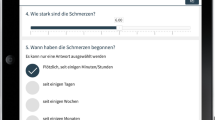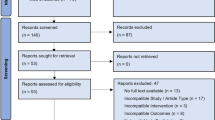Abstract
There is now a requirement for every doctor in the UK to obtain patient feedback for revalidation. This can be an onerous and time-consuming task. The objective of this study was to evaluate a novel electronic patient feedback method in an outpatient lithotripsy service setting. Between September 2013 and January 2014, 100 patients attending an outpatient lithotripsy service in Oxford were asked to complete a selection of pre-approved NHS questions about the service they had received. Questions were presented on a tablet device (iPad™) and answered using the touch screen. Departmental staff were unaware of the questions in the survey. Patients were asked to complete the survey by an independent research nurse. Questions were created online in a free-to-use web-based survey application and presented on the tablet device in a user-friendly format via an application. Data were uploaded via wifi™ to the online system. Data were viewed, automatically analysed and displayed graphically. The age range of the patients surveyed was 20–80 years of age. All 100 patients completed the survey without difficulty. All patients answered every question. Data could be automatically viewed, analysed and presented graphically. This method of collecting patient feedback proved to be rapid and efficient. The feedback highlighted a high patient satisfaction with the lithotripsy service. A touch screen tablet device is an efficient and effective method of collecting truly objective patient feedback. This method of patient feedback could be employed in other clinical environments to collect data for revalidation purposes.
Similar content being viewed by others
Avoid common mistakes on your manuscript.
Introduction
In December 2012 revalidation was introduced for all practicing doctors in the UK by the General Medical Council (GMC). The majority of doctors will have to undergo their first revalidation by March 2016. Revalidation is the process by which licensed doctors are required to demonstrate that they are fit to practice. Doctors will have to revalidate quinquennially.
GMC guidelines outline six types of supporting information that must be provided for discussion at appraisal at least once in each 5-year cycle: continuing professional development, quality improvement activity, significant events, feedback from colleagues, feedback from patients and a review of complaints and compliments [1].
Patient feedback is intended to help doctors to reflect on their practice and support their professional development by providing them with information about their practice through the eyes of those treat. Seeking feedback using a questionnaire enables patients’ views about a doctor’s practice to be gathered in a systematic way. However, collection of patient feedback is potentially an onerous and time-consuming task because questionnaires should be distributed by an independent person (to avoid potential selection bias and coercion of patients) and data from paper questionnaires need to be converted into an electronic format to for analysis and presentation.
Our objective was to evaluate the use of a tablet device (iPad™) to collect patient feedback electronically in an outpatient lithotripsy setting. To our knowledge, this is the first study to evaluate this method of patient feedback.
Methods
Between September 2013 and January 2014, 100 patients attending for lithotripsy were asked to provide electronic feedback about the lithotripsy service after their treatment. All patients received the same treatment on a Storz modulith F2 lithotripter. All patients received the same pre-procedure analgesia, antibiotics, and antiemetic. Lithotripsy was delivered according to our standard protocol with audiovisual distraction as described previously [2]. Prior to discharge, patients completed 17 questions on a touch screen device (iPad™) (Table 1). Departmental staff (radiographers and nurses) were not involved in choosing the questions and were unaware of the questions in the survey. Patients were asked to complete the survey by an independent research nurse in private. Patients did not receive or need any instruction and completed the survey without direction from the research nurse. The iPad™ was mounted in a secure stand (Bouncepad). Questions were selected from a pre-approved list of day-case surgery and outpatient clinic NHS feedback questions. Questions were entered online in a free-to-use survey application (QuickTapSurvey) and presented on the tablet device in a user-friendly format (Fig. 1). Answering each question required single touch selection and did not require text entry. Data from the iPad™ were uploaded via wifi™ to the online system. Data were viewed and then automatically analysed and displayed graphically.
Results
The patients surveyed were 62 % male and 38 % female and from a wide range of age groups (20s–70s) which reflects the epidemiology of stone disease [3]. All patients completed every question without difficulty. Data were presented in a user-friendly format with simple touch-screen options (Fig. 1). Data were collected in several areas including patient demographics, the booking process, staff courtesy and teamwork, consent and explanation, and an overall assessment of the service (Figs. 2, 3, 4, 5). There were no significant differences in ratings between men and women.
Proportion of patients that felt they had been consented properly. Patients were asked if the risks and benefits were explained adequately (a) (Q11), whether patients had an understanding of what the procedure involved (b) (Q12) and whether they understood how they could expect to feel after the procedure (c) (Q13)
Discussion
This pilot electronic patient feedback study using an iPad™ exemplified the ease in which patient feedback can be obtained for a service or individual. Standard GMC questions can be customised to address a particular department’s or individual’s requirements. The ease in which data can be collected not only facilitates the GMC revalidation process but also provides evidence to support the improvement of patients’ services.
One concern with any new technology is that it is not equally accessible by all sectors of society and thus biases collection and interpretation of data. Recent evidence, however, suggests that tablet devices can be used successfully in different population groups [4–8] and this is supported by our study which involved patients covering a wide age range.
This pilot study demonstrated that this is a readily adopted method of patient feedback. The Patients can be reassured that their feedback is completely anonymised, so allowing them to give an objective assessment of a service or doctor.
The same approach could be employed in many other clinical environments (outpatients, day surgery units and wards) to assess different aspects of medical practice and different members of a medical team. Following the Francis report [9], it is clear that the healthcare profession needs to be more aware of patient experiences and is accountable if standards fall. The ease of data collection using electronic methods such as those described facilitate audit and objective reporting to identify areas of strength and weakness within a department. Patient feedback provides evidence to support direction of resources to implement training and service change where required. Furthermore, methods employed by services with high satisfaction scores can be disseminated as examples of best practice.
Conclusions
This study has demonstrated that a touchscreen tablet device is an efficient and effective method of collecting patient feedback. This patient feedback tool could be employed in other clinical environments to collect data for revalidation purposes.
References
Council GM. Available from: http://www.gmc-uk.org/Supporting_information100212.pdf_47783371.pdf
Marsdin E, Noble JG, Reynard JM, Turney BW (2012) Audiovisual distraction reduces pain perception during shockwave lithotripsy. J Endourol 26(5):531–534
Turney BW, Reynard JM, Noble JG, Keoghane SR (2012) Trends in urological stone disease. BJU Int 109(7):1082–1087
Zarghom S, Di Fonzo D, Leung FH (2013) Does socioeconomic status affect patients’ ease of use of a touch-screen (iPad) patient survey? Interact J Med Res 2(1):e1
Goodyear-Smith F, Warren J, Bojic M, Chong A (2013) eCHAT for lifestyle and mental health screening in primary care. Ann Fam Med 11(5):460–466
Chalil Madathil K, Koikkara R, Obeid J, Greenstein JS, Sanderson IC, Fryar K et al (2013) An investigation of the efficacy of electronic consenting interfaces of research permissions management system in a hospital setting. Int J Med Inform 82(9):854–863
Onoda K, Hamano T, Nabika Y, Aoyama A, Takayoshi H, Nakagawa T et al (2013) Validation of a new mass screening tool for cognitive impairment: cognitive assessment for dementia, iPad version. Clin Interv Aging 8:353–360
Fritz F, Balhorn S, Riek M, Breil B, Dugas M (2012) Qualitative and quantitative evaluation of EHR-integrated mobile patient questionnaires regarding usability and cost-efficiency. Int J Med Inform 81(5):303–313
Francis R. Available from: http://www.midstaffspublicinquiry.com/report. Accessed 14 Apr 2014
Conflict of interest
The authors declare that they have no conflict of interest.
Author information
Authors and Affiliations
Corresponding author
Rights and permissions
About this article
Cite this article
Turney, B.W., Reynard, J.M. Obtaining patient feedback in an outpatient lithotripsy service is facilitated by use of a touch-screen tablet (iPad™) survey. Urolithiasis 42, 317–321 (2014). https://doi.org/10.1007/s00240-014-0662-3
Received:
Accepted:
Published:
Issue Date:
DOI: https://doi.org/10.1007/s00240-014-0662-3









